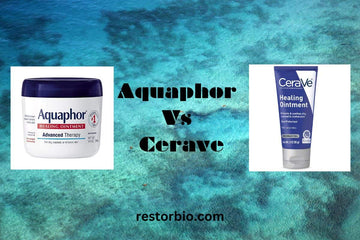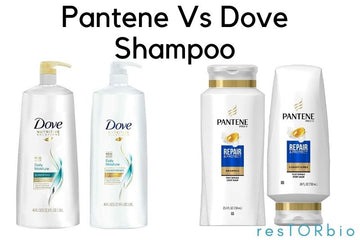
In the realm of skincare, there are few battles as fiercely contested as the one between Aquaphor Healing Ointment and Cerave Healing Ointment. Both of these heavyweights have garnered a loyal following, with each boasting a unique blend of ingredients that promise to soothe, repair, and protect the skin. But as they vie for the title of the ultimate healing ointment, it's time to take a step back and examine what truly sets them apart, and more importantly, which one is better suited for your skin's specific needs.
In this Aquaphor Vs Cerave comparison, we'll delve into the science behind these two popular ointments, analyzing their ingredients, formulation, and overall effectiveness for various skin conditions.
By understanding the strengths and weaknesses of Aquaphor and Cerave, you'll be well-equipped to make an informed decision on which healing ointment is the best choice for your skincare arsenal. So, let's embark on this journey of discovery and find the true champion in this battle for healing ointment supremacy.
Aquaphor Vs Cerave: Overview
When it comes to skincare, choosing the right product is paramount. Two popular ointments that have garnered the attention of skincare enthusiasts worldwide are Aquaphor Healing Ointment and CeraVe Healing Ointment. Both products promise to heal, protect, and soothe the skin, but how do they compare? Let's dive into the key differences and similarities between these two acclaimed ointments.
About Aquaphor

Aquaphor Healing Ointment has long been a staple in the skincare industry, revered for its ability to soothe and repair a plethora of skin concerns. Its gentle yet powerful formula, which includes ingredients such as petrolatum, mineral oil, ceresin, lanolin alcohol, panthenol, glycerin, and bisabolol, creates a protective barrier on the skin that locks in moisture, promotes healing, and alleviates discomfort. Suitable for all skin types, Aquaphor Healing Ointment is particularly effective in treating extremely dry, cracked, and irritated skin, making it an essential addition to any skincare routine.
What sets Aquaphor Healing Ointment apart from its competitors is its versatility. Not only is it effective in treating common skin concerns, but it can also be used as a lip balm, cuticle moisturizer, and even as a barrier to protect the skin from external irritants, such as during the hair dyeing process. Its thicker, more occlusive texture ensures that the skin receives long-lasting hydration and protection, making it an ideal choice for those who suffer from persistent dryness or live in harsher climates. With its proven track record and wide range of uses, Aquaphor Healing Ointment remains a trusted and reliable skincare solution for individuals seeking relief and rejuvenation.
About Cerave

CeraVe Healing Ointment has quickly become a go-to product for those seeking a lightweight yet effective solution to various skin concerns. Its unique formulation, which includes ceramides, hyaluronic acid, and petrolatum, works synergistically to restore the skin's natural barrier, lock in moisture, and promote healing. Moreover, CeraVe's patented MultiVesicular Emulsion (MVE) technology ensures a controlled release of ingredients, providing prolonged hydration and making it suitable for all skin types, including those with sensitive skin.
In addition to its impressive list of ingredients and cutting-edge technology, CeraVe Healing Ointment boasts a smooth, non-greasy texture that absorbs easily into the skin. This makes it a versatile option not only for treating dry, cracked, and irritated skin, but also for use as a daily moisturizer, lip balm, or even a makeup primer for individuals with dry skin. Its lightweight feel ensures that it can be comfortably incorporated into any skincare routine without feeling heavy or causing breakouts. With its innovative formula and myriad of uses, CeraVe Healing Ointment has established itself as a trusted and reliable skincare solution for those seeking effective, long-lasting relief and protection.
Aquaphor Vs Cerave: Review
In the world of skincare, finding the perfect product to heal, protect, and soothe your skin can be a daunting task. Two contenders that have risen to prominence in recent years are Aquaphor Healing Ointment and CeraVe Healing Ointment. While both ointments promise to deliver effective results in addressing various skin concerns, they each bring unique formulations and characteristics to the table. In this brief review, we will compare and contrast the key features of these two acclaimed ointments, helping you determine which one is the most suitable choice for your skin's needs and preferences.
Aquaphor Review

As someone who has struggled with dry, sensitive skin for years, I was on a constant quest to find a product that could provide the much-needed relief and hydration I desired. After trying countless lotions and creams, I stumbled upon Aquaphor Healing Ointment, and it has become a true skincare savior in my routine. The thick, emollient texture creates a protective barrier on my skin, locking in moisture and providing immediate relief for my dry, cracked, and irritated areas. I was pleasantly surprised by the versatility of Aquaphor, as it worked wonders not only on my skin but also as a lip balm and cuticle moisturizer.
I must admit, the heavier texture of Aquaphor Healing Ointment can feel a bit greasy at times and might be challenging to spread, especially during warmer months. However, the benefits of this product far outweigh this minor inconvenience, and I've found that applying it sparingly helps to alleviate any greasiness. Overall, I can confidently say that Aquaphor Healing Ointment has earned its place as a staple in my skincare routine, and I couldn't be happier with the results it has delivered for my skin.
Cerave Review

I've always been on the lookout for a product that could effectively address my dry, flaky skin without causing irritation or breakouts. It was not until I discovered CeraVe Healing Ointment that my search finally came to an end. This ointment has a unique blend of ceramides and hyaluronic acid, which not only moisturizes my skin but also helps maintain its natural protective barrier. I particularly appreciate the non-comedogenic formula, as it doesn't clog my pores or cause breakouts, despite its thicker consistency.
The texture of CeraVe Healing Ointment is slightly lighter compared to other similar products I've tried, making it easier to apply and absorb into my skin without feeling overly greasy. As someone with sensitive skin, I also appreciate that the ointment is fragrance-free, reducing the risk of irritation. While the initial application may leave a slightly shiny finish, it quickly subsides, leaving my skin feeling soft and nourished. Overall, I can't imagine my skincare routine without CeraVe Healing Ointment—it has truly made a noticeable difference in my skin's health and appearance.
Which is Better: Aquaphor Vs Cerave?
In my personal experience, choosing between Aquaphor Healing Ointment and CeraVe Healing Ointment truly comes down to individual needs and preferences. While Aquaphor's thicker consistency and occlusive barrier work wonders on severe dryness and cracked skin, I find CeraVe's lighter texture and inclusion of ceramides and hyaluronic acid more suitable for my sensitive, acne-prone skin. The non-comedogenic and fragrance-free formula of CeraVe Healing Ointment gives me peace of mind knowing it's less likely to cause breakouts or irritation. Ultimately, both products offer impressive results, but for me, CeraVe Healing Ointment has proven to be a better match for my specific skin concerns and preferences.\
Comparison Between Aquaphor Vs Cerave
In this comparison, we will delve into the key differences between Aquaphor and CeraVe Healing Ointments, examining their formulations, benefits, and suitability for various skin types. This analysis will provide valuable insights and help you determine which ointment is the perfect match for your skin's specific needs.
| Features | Aquaphor Healing Ointment | CeraVe Healing Ointment |
| Consistency | Thicker | Lighter |
| Barrier Protection | More occlusive | Less occlusive |
| Key Ingredients | Petrolatum | Ceramides, Hyaluronic Acid, Petrolatum |
| Texture | Greasier | Creamier |
| Fragrance-free | Yes | Yes |
| Non-comedogenic | No | Yes |
| Best for Skin Types | Extremely dry, cracked skin | Sensitive, acne-prone skin |
| Price | Slightly cheaper | Slightly more expensive |
| Additional Benefits | Multi-purpose (lips, hands, etc.) | Helps restore skin's natural barrier |
| Absorption Time | Slower | Faster |
| Suitable for Babies | Yes | Yes |
Aquaphor Vs Cerave Key Ingredients

Aquaphor Healing Ointment and CeraVe Healing Ointment are two highly popular skincare products that have garnered a dedicated following for their ability to soothe and heal various skin conditions. While both products share a common goal, their key ingredients set them apart from one another. Aquaphor Healing Ointment's primary ingredient is petrolatum, a highly effective occlusive agent that protects the skin by forming a barrier to lock in moisture and prevent water loss. In addition to petrolatum, Aquaphor also contains glycerin, which acts as a humectant to attract and retain moisture, as well as panthenol, which promotes skin healing and regeneration.

On the other hand, CeraVe Healing Ointment also utilizes petrolatum as its main ingredient but distinguishes itself with the inclusion of ceramides. These lipid molecules are essential for maintaining a healthy skin barrier and are naturally found in the skin. By incorporating ceramides into the healing ointment, CeraVe helps to replenish and strengthen the skin barrier, while also providing long-lasting hydration.
Another key ingredient in CeraVe Healing Ointment is hyaluronic acid, a powerful moisturizer that can hold up to 1,000 times its weight in water, further enhancing the product's hydrating properties. As a result, the choice between Aquaphor and CeraVe Healing Ointments ultimately depends on individual skincare needs and preferences, with Aquaphor focusing on skin protection and regeneration, and CeraVe emphasizing barrier repair and hydration.
Aquaphor Vs Cerave Consistency and Texture

When it comes to consistency and texture, Aquaphor Healing Ointment and CeraVe Healing Ointment offer unique experiences that cater to different preferences. Aquaphor Healing Ointment has a thick and somewhat greasy texture that is often associated with its high petrolatum content. This heavy-duty consistency is designed to provide a robust barrier that locks in moisture and aids in the healing process, making it ideal for extremely dry, cracked, or irritated skin. However, due to its thickness and slightly sticky feel, some users may find Aquaphor less suitable for everyday use or for application on larger areas of the body.

In contrast, CeraVe Healing Ointment boasts a lighter and creamier texture that spreads easily and absorbs more quickly into the skin. This is largely attributed to its unique formulation, which includes ceramides and hyaluronic acid. The presence of these ingredients not only enhances the ointment's moisturizing properties but also contributes to its less greasy and more comfortable feel upon application.
As a result, CeraVe Healing Ointment is often preferred by those seeking a more cosmetically elegant option that can be used daily or on larger areas without feeling weighed down. Ultimately, the choice between Aquaphor and CeraVe Healing Ointments in terms of consistency and texture will depend on individual preferences and specific skincare needs, with Aquaphor offering a more heavy-duty, protective feel and CeraVe providing a lighter, more user-friendly experience.
Aquaphor Vs Cerave Absorption Time

Aquaphor Healing Ointment and CeraVe Healing Ointment are designed to provide relief and protection for various skin concerns, but their absorption times differ due to the variations in their consistency and formulation. Aquaphor Healing Ointment, with its thick and greasy texture, takes longer to absorb into the skin.
This is mainly due to the high petrolatum content, which creates a strong barrier and locks in moisture but may leave a slightly heavy or occlusive sensation on the skin. For some users, particularly those with severely dry or cracked skin, the longer absorption time of Aquaphor can be beneficial, as it allows the product to work its magic over an extended period, providing continuous protection and hydration.

In comparison, CeraVe Healing Ointment is known for its quicker absorption time, thanks to its lighter and creamier texture. The presence of ceramides and hyaluronic acid in the formula not only enhances the product's moisturizing capabilities but also allows it to penetrate the skin more easily. This faster absorption is often preferred by individuals who seek a less greasy and more comfortable feel when applying a healing ointment.
The quicker absorption time of CeraVe Healing Ointment makes it a more suitable option for daily use or for application on larger areas of the body without leaving a heavy, sticky residue. In summary, the choice between Aquaphor and CeraVe Healing Ointments in terms of absorption time will be dictated by personal preferences and specific skincare requirements, with Aquaphor offering a slower absorption for prolonged protection, and CeraVe delivering a faster absorption for a more lightweight and comfortable experience.
Conclusion: Aquaphor Vs Cerave
In conclusion, both Aquaphor Healing Ointment and CeraVe Healing Ointment are outstanding products with unique formulations designed to address various skin concerns. Aquaphor, with its emphasis on petrolatum-based skin protection and regeneration, offers a thicker consistency and longer absorption time that is well-suited for extremely dry or irritated skin.
On the other hand, CeraVe Healing Ointment, with its blend of ceramides and hyaluronic acid, provides a lighter texture and faster absorption time, making it a more cosmetically appealing choice for daily use or on larger areas.
When deciding between these two healing ointments, it is essential to consider individual preferences and specific skincare needs, as both products have their own distinct advantages and can be highly effective solutions for maintaining healthy and hydrated skin.
Read More:
Aquaphor Vs Cetaphil: Which is Better in 2023 – My Honest Review?




